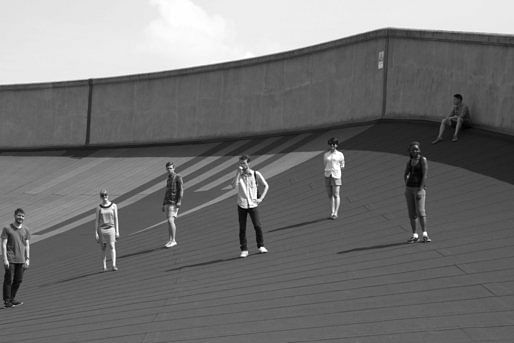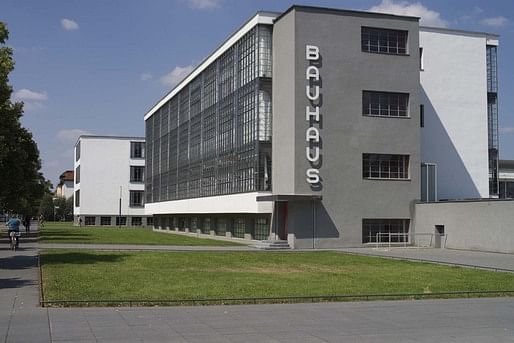
The Taubman College Spring Travel Course Experience is an interview series with students who have participated in the course and want to share their experiences with other students.


There are many European travel courses offered at Taubman College, but not many that covered 17 different cities. The Path of Kahn travel course was significant because it looked European architecture as well as American architecture. The trajectory of the trip was interested in understanding how the industrial architecture of Albert Kahn in Detroit influenced modern architecture in Europe. The students were able to juxtapose the cultural and historical context between the buildings they visit abroad, as well as some of the ones closer to home right in Detroit. Their collective research and experiences can be found at PathofKahn.com. This course was led by Claire Zimmerman.
Claire Zimmerman is an Associate Professor of History of Art and the Coordinator of Doctoral Studies in Architecture at the Taubman College of the University of Michigan. She teaches courses on 19th and 20th century European and American architecture with research emphases on architectural media and in Weimar Germany and the United Kingdom. Current research interests include architecture culture as it interacts with commerce and industry, and the infrastructures of globalization that underpinned the spread of modern architecture throughout the 20th c.
Although the course is not offered for Spring 2015, Yun Yun and Alan Lucey, both in their second year of the M.ARCH (three year) degree, agreed to give some insights on their travel experiences and why a travel abroad course is worth some consideration.
Yun, I understand this is your first time in Europe, what was your first impression? Was there any culture shock?
Yun: To be honest, I think there were more similarities between China and Europe than the U.S. and Europe. The way the city is organized feels more like China.
What about your experience traveling to so many cities with a group of people?
Yun: It’s interesting because in the beginning, we didn't know each other at all, but we traveled together and worked together. We got really close by the end of the trip and we actually didn't get sick of one another.
So you were constantly together and you didn't get sick of one another?
Yun: Not constantly, we had moments where people would split up in smaller groups or go off individually and do their own thing, but we spent a lot of time together and it was a lot of fun!
That’s good, everyone needs their space right?
Yun: Yeah exactly. I thought we would need more of it, but with our group we all just got along really well. There were seven of us, plus Claire there were 8, so it was a really good number. I think it’s a challenge to travel with a larger group, but it’s also nice because you get different perspectives on things. Someone would say something or point out certain things that I would have never thought of.

Yeah, absolutely! Do you think that was one of the highlights of your trip? To learn and gain perspectives from other people while also learning about the architecture?
Yun: Yeah, and especially from Claire Zimmerman, she’s so knowledgeable and having her there to constantly answer our questions was great.
Do you have any advice for students who are about to go on a travel course?
Yun: Yes, do as much research as possible on the places they will visit. That way, when they’re there, they will be able to pick up on the context of the city and the architecture. You’ll understand better once you have something to go off of.
What about travel advice in general?
Yun: Don’t bring too much stuff, my luggage was so heavy! Be smart about what you bring and be open-minded. Also be nice to people!
“Be nice to people,” did you have any bad encounters with Europeans?
Yun: No, everyone is so nice, but just in general, be nice as a foreigner.
You visited 17 cities, was there one with a particular cuisine that you’re dying to eat again?
Yun: The best food is in Italy! Definitely eat a lot if you’re in Italy.
Is there anything you would do differently on the trip?
Yun: Yeah! So we had free days where Claire didn’t plan anything and we had the opportunity to do our own thing and I didn’t really plan anything. So if I did it again, I would plan for those free days and do more things.
I was about to ask Yun what was her favorite thing about the, when Alan Lucey, joined our conversation and the question was bestowed on him.
Alan: Everything was awesome! I mean one amazing thing on the top of my head was going to the Venice Biennale.
I’ve interviewed a few people now who have all said that travel changed the way they designed, do you agree, if so how?
Yun: Yes for sure! You get to see so many things that you haven’t seen before and it makes you more open-minded to the possibilities.
I asked Yun this earlier, what’s a good piece of advice you have for students about to go on a travel course?
Alan: Don’t bring a hiking backpack, bring a rolly suitcase. Don’t think you have to backpack; there are places where you can put your stuff!
So for Yun the advice is to not pack too much, and for you is to bring a real suitcase! That’s great!
If you are do the course again, what would you do differently?
Alan: I would bring a roller suitcase. I mean…. Claire’s schedule for us was pretty rigorous so everything we saw was well worth it.
What would you say is one of the benefits of taking an architecture travel course?
Alan: It just gives you a whole new set of references. You may have come across it in a book, but there’s a whole set of architecture that when you walk around and talk about it, it registers completely different in your mind. It’s like the model of it will stay in your mind.
Yun: It’s being able to see your own perspective of the architecture, not just the photographer’s perspective.
Alan: And also the afterlife of the important buildings. Seeing the condition they are in now, how they function or don’t function. How they’ve been maintained or not, how they’ve changed over time.
Were there any buildings that took you by surprised in some ways? Based on what you learned or read about and then seeing it and experiencing in person?
Both: Yeah of course!
Alan: For me, the Lester engineering building by James Sterling was a lot smaller than I thought.
Yun: Yeah that was quite a strange building. I think the Bauhaus also looked a lot smaller than I had imagined.

What was a culture shock for you when you went to Europe Alan?
Alan: I’ve been to Europe before, but for me what stood out about Europe and the U.S. this time around is the liability culture between the two. Certain things in America just aren’t allowed because people sue all the time, but in the Europe it’s not the case. For instance, I’m designing this ledge, and in the U.S. I have to make sure a baby’s head wouldn’t get stuck in it because here you have to design thinking you may get sued at any moment. Like if someone slipped and fell 100 ft. and died, it may be about the design, whereas in Europe, they’ll just say, 'eh put a sign up and if you fall, you fall.
In your mind, what was the significance of the course for you?
Alan: I think just situating Albert Kahn’s industrial architecture is very significant. I didn’t know that it was being referenced by all these other architects like Corbusier and Walter Gropius. All of these people were looking at Detroit’s industrial architecture and Americanism, and it influenced a whole generation of European modernists which is pretty amazing. Being able to see that manifest in the architecture was pretty significant.
Great, well it seemed like you both highly enjoyed your time there, do you have any final thoughts about your experience and for other students who are interested in a travel course?
Both: Highly recommend it! Do it!
Alan: I want to go back!


Sharing insights from Taubman College of Architecture and Urban Planning at the University of Michigan.



No Comments
Block this user
Are you sure you want to block this user and hide all related comments throughout the site?
Archinect
This is your first comment on Archinect. Your comment will be visible once approved.